The story of Reedsmouth Junction: Brief Encounter
The story of Reedsmouth Junction: Brief Encounter
Whilst the world around him was welcoming the arrival of 1948 with laughter, drink and song, Isaac Elliott took to his bike for a nine-mile trek across the hills of Northumberland. This was not a bizarre expression of his youthful exuberance. As the clock struck midnight, he joined the mass ranks of railwaymen as cleaner-fireman at Reedsmouth, a posting which would prove the most gratifying of his working life. But that first shift had a surprise in store. After two hours of unremarkable solitude, a sodden apparition came knocking at the shed door. It was a surreal twist which lived long in Isaac’s memory.
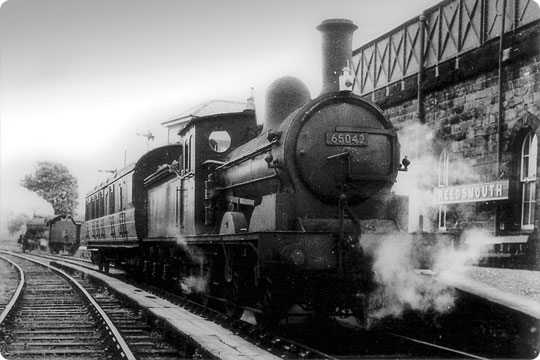
Reedsmouth was a humble community of railway cottages, fifteen miles up the line from Hexham, at the junction of the Border Counties and Wansbeck railways. The latter cut a meandering path east to Morpeth whilst the former headed west to climb the North Tyne valley, joining the famous Waverley route in the high fells at Riccarton. This desolate place gave Reedsmouth the feel of a bustling metropolis.
Promoters of the Border Counties Railway thought their feet were firmly on the ground, even if their commercial future lay some distance beneath it. With the prospect of meagre revenues from local passenger traffic, they set their sights on supposedly rich reserves of coal, estimated at more than 100 million tonnes. These, coupled with rejuvenated iron furnaces at Bellingham, would form a solid industrial base from which a new rail link – with buffer stops just beyond Falstone – could profit.
Optimism subsided in June 1854 when a Select Committee sat to consider the prospectus. Opposition was unexpectedly fierce and well prepared, calling into question both the viability of the coal deposits – which had not been surveyed – and the line’s proposed timber structures, deemed unsuitable given the strength of local river currents. With its shortcomings exposed, relief must have been palpable when the scheme successfully negotiated these choppy parliamentary waters by July’s end.
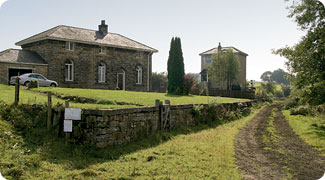
Colour photos: Four by Three
But the great British institution of friends in high places had delivered a hollow victory. Investors ran from the deafening alarm bells. As cash stopped flowing, the scheme fell into disarray, running years behind schedule. Contractual shenanigans between overbearing engineer, J H Tone, and his builder, William Hutchinson of Hartlepool, added to the sense of impending doom. This dysfunctional relationship cast a long shadow over the project.
It was shortly before Christmas 1855 when shovels were first heard on the Tyne’s south bank near Hexham, where the single line of the Border Counties diverged from the Newcastle & Carlisle. Within a month, Tone was back at his drawing board – he spent a lot of time there – redesigning the 440-foot river crossing which had already run into difficulties. Silence prevailed for more than a year. When work finally resumed, the viaduct rose from the water in just 14 months but at a price double the original estimate. By now, the company was struggling to stay afloat.
Chollerford, just four miles from the junction, enjoyed the role of temporary terminus when wagons first rolled in April 1858. Progress thereafter continued at a snail’s pace – indeed, the parliamentary powers vested in the company would have expired long before construction was even close to completion. Relief arrived during the summer of 1859 in the form of a second Act authorising an extension into Scotland to meet the Border Union railway and a deviation at Reedsmouth where the planned Wansbeck route would join. Twelve months on, the Border Counties Railway merged with the North British, finally placing its finances on a firm footing.
Rails were eventually laid into Falstone in September 1861, more than seven years after the original 26-mile plan was rubber-stamped. A siding and incline provided the connection to the large colliery at Plashetts, of which Tone was the first leaseholder. The 16-mile section through to Riccarton received the Board of Trade’s nod of approval in April 1862 though, with work there also behind schedule, it was not until 24th June that the ribbon was cut on the goods service. Passenger trains were shining the rail-top one week later.
Acrimony between engineer and contractor persisted to the end. Tone pointed the finger of blame for the line’s belated opening firmly and unfairly at Hutchinson, activating harsh penalty clauses. With all payments frozen, Hutchinson was declared bankrupt before the year was out. Legal action rumbled on for four years, concluding in a farcical tribunal over which Tone was appointed arbiter. Details of the settlement have not survived.
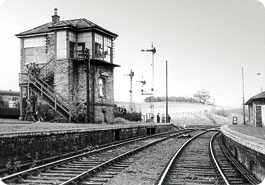
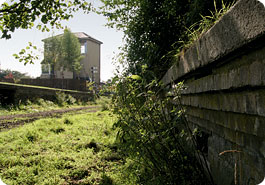
For Reedsmouth, the rapid approach of Wansbeck metals drove its sudden transformation from humble halt to principal staging post. Rebuilt as early as 1864, its main building was dominated by a vast water tank, perched on its roof, holding upwards of 60,000 gallons. These were guzzled from a moorland stream. Offices and a waiting room sheltered beneath. The Counties side comprised two platforms – allowing passenger trains to pass, though they rarely did – whilst a generous marshalling yard was installed on the eastern side, with turntable, weighbridge and accommodation for livestock. Standing sentinel on the platform end was an imposing signal box, overlooking the pointwork. Initially the only one on the line, it was joined by half a dozen others when Absolute Block signalling entered the statute books in 1889.
Motive power for both the Wansbeck and Counties was housed at Reedsmouth. Three local passenger trains ran each way during the day, with specials added when needs must. Through services linked Newcastle to Hawick and Edinburgh, a somewhat futile venture by the North British which liked to think of the route as an alternative Anglo-Scottish main line. Journey times were awful. On the goods side, coal headed north, though never in the quantities foreseen by the line’s promoters, whilst agricultural supplies made the trip inbound.
In the 1920s, a national reserve of timber was established, with the largest development consuming 120,000 acres of moorland around Kielder. By the start of the Second World War, forestry was a major employer throughout the district. Working at its fringe was a young Isaac Elliott who was helping to fell trees for ten shillings a week. The Wansbeck had attracted a saw mill to his home village of Knowesgate, where his dad was a platelayer. Timber went out by rail. Their modest cottage had neither water nor electricity, but boasted a train at the back door and bus at the front.

Elliott Junior served his country with both Army and Navy, gaining quite an education during a year-long turn of duty in India. Discharged in 1947, his father’s footsteps soon lead him into gainful employment on the railway, preparing engines over the hills at Reedsmouth.
That career got off to an unsociable start at midnight on New Year’s Eve. A solitary light glowed by the shed door though, inside, it was lifeless – just a handful of locos sleeping peacefully in the gloom. So it was quite a revelation when, two hours after clocking-on, the silence was broken by a knock at the door. “I thought Gabriel had landed!” jokes Isaac. He peered out to see a girl shivering in the shadows. “I think she was a Land Army type – something like that. She had an overcoat on but was absolutely soaked to the skin. I’m quite sure she’d crossed one of the rivers.”
Our hero brought her in, took her coat – “just her coat, mind!” – and sat her by the fire to thaw. In spite of his care and hospitality, not a word passed her lips. Perhaps her jaws had frozen shut. “We had a bothy outside – an old carriage with a fire in. I lit it and, after it took hold, I put her in there for the night.” Eventually she found her voice and asked “Will you see I get the Kielder train in the morning?”
Duly installed on that first service north, the damp damsel disappeared in a cloud of smoke, never to be seen again. “To this day, I don’t know who she was. It was one of the mysteries of life” Isaac muses.
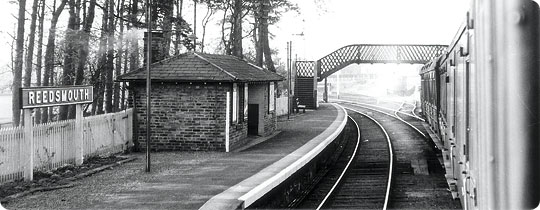
A cleaner’s lot did not often feature such intrigue. It was a tough, dirty business, involving an early start to get the engine fired ready for the driver. “If it wasn’t lit, you were in trouble! I used to leave home at two-thirty in the morning and cycle to Reedsmouth for four o’clock. After a week or two, I got board and lodgings in the village which helped a bit. It took about two-and-a-half hours to get the engines steamed up.” Like people, these living machines could be temperamental. “On damp mornings, the fires would hardly burn at all!”
Reedsmouth shed was brick-built and occasionally played host to six locos, mainly J21s and J36s. Some of them were still going strong at retirement age. Eight men were based there – four drivers and four cleaner-firemen. As the junior, young Elliott would often find himself booked on the Saturday night train out of Hexham, heading up to Kielder. It was not a popular turn – the old hands took the day off. “There was no turntable at Kielder so you’d come back tender first. Whatever was coming out of the heavens, you got a bit of it!”
Hands were rarely idle. Carriages and engine had to be coupled, taking care to dodge the buffers. Water was taken daily to slake the thirst of a crossing keeper. And then there was the coalman who was always thankful for help with his load. Digging into that was “absolute slavery”.
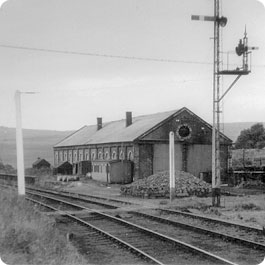
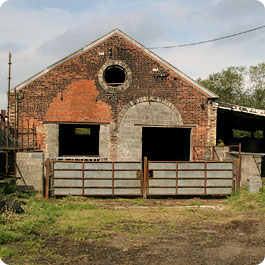
After a few months in service, each locomotive was taken down to Blaydon to have its boiler washed out. “It was an easy shift, that one!” On a return journey, Isaac and driver once stopped for water at Hexham. As the huge pipe was coaxed into the tender, a Newcastle-bound train pulled in alongside. Its passengers turned to watch the action. Regrettably, the driver was a little over-enthusiastic with the valve. “He turned it on too quickly, the pipe bent, lifted out and the water went straight in through the carriage window opposite!” A swift departure was called for.
Firing was a skill which got easier with practice. Good drivers offered advice; others said nothing – just gazed across at the steam gauge. “You knew what that meant – get it stoked up!” Footplate relationships varied. “The majority of drivers were alright but some didn’t trust you. If there was a signal on your side, you’d tell him what it was showing but they’d still come across and have a look.”
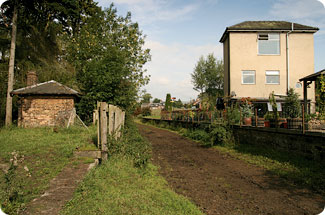
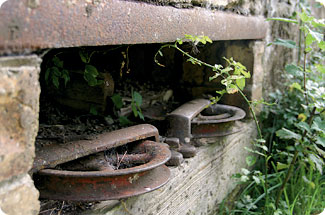
Pride was in plentiful supply and everyone tried to do the job right. The railway was run with locals in mind, not management. After a Saturday shopping trip to Morpeth, the platelayer’s wives would be dropped at their door, half way between two stations. As a thank you, they’d give the crew chocolate bars. Lumps of coal were shared with all and sundry. And, when the Scotgap stationmaster’s goat passed away, the driver offered to cremate it in the firebox.
Scotsgap sat at the Wansbeck’s midpoint and visits there often involved a bit of shunting in the yard. Tragedy could strike if those working lineside didn’t have their wits about them during these slow, quiet movements. In one episode, the guard didn’t hear the approaching engine and, as Isaac recalls, “he stepped into the line and it took his foot clean off.” The unfortunate soul succumbed to his injuries a couple of weeks later.
By the 1950s, both the Counties and the Wansbeck were also struggling to survive. When Northumberland’s highways had been upgraded 30 years earlier, railways shouldered the burden of carrying stone to the roadworks. Ironic then that affordable motor cars caused their demise, prompting an exodus from rail to road. “By the end, we’d just have two or three passengers on, or a bundle of Evening Chronicles. It couldn’t have been paying. Originally, the railway meant everything because of the lack of road transport but eventually that’s what killed it.”
The plug was pulled on the Wansbeck’s passenger service in September 1952. The Counties’ kept rolling for four more years and it was the autumn of 1958 before the last through goods trip ran. The mile-and-a-half section from Reedsmouth to Bellingham clung to life as an extension of the Wansbeck though, when this was abandoned on 9th November 1963, one hundred years of community service was brought to a disappointing end. The Wansbeck completely shut up shop in October ’66.
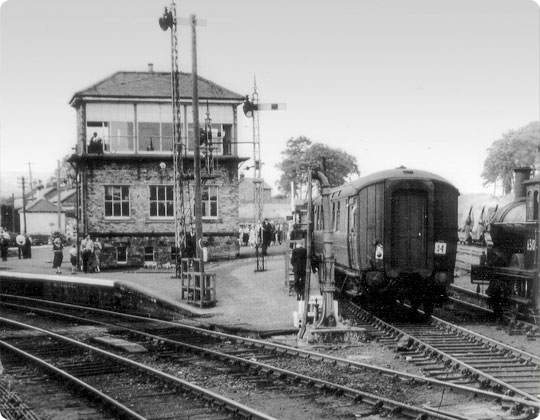
Whilst the iron deck of Border Counties viaduct is long gone, its concrete foundations still stand like giant stepping stones across the Tyne. The trackbed beyond Falstone was overwhelmed by Kielder Reservoir during the Seventies, yet much of the remainder can still be traced and, in parts, is walkable. At Reedsmouth, the decaying shell of the engine shed now benefits a local farmer. Both the station building and signal box are reborn as dwellings.
For Isaac Elliott, the railway’s decline was sad, if inevitable. British Rail dangled the carrot of employment in Hull – a prospect with no appeal so he chose a career change, signing up with the forestry which kept him busy for forty years. “I never had any complaints about the railway except for starting at that ridiculous time! It was the best job I ever had and I was quite sorry when it packed up.” That’s progress, isn’t it?
Visitors to the area can journey back to the Border Counties’ heyday through a photographic exhibition at the Bellingham Heritage Centre. It also lodges a collection of memorabilia, including signs, tools and even a station clock. Opening times are from 1030-1630, Friday through to Monday, from Easter until the end of September. There’s a small entrance fee. For more information or to arrange a group visit, call 01434 220050.
More Information
| Northumberland Railways | Statistics, history and archive shots of the Border Counties |
| RailScot | Timeline and contemporary photos of the route |
| Bellingham Heritage Centre | Exhibition of Border Counties’ photographs and memorabilia |






